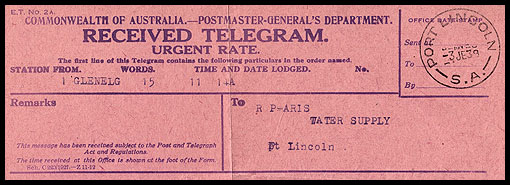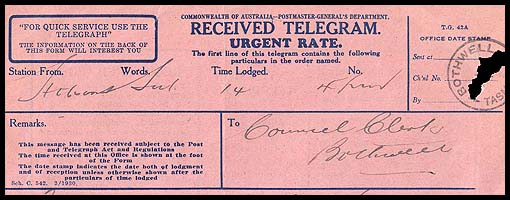Urgent rate delivery forms.
- Home, index, site details
- Australia 1901-1988
- New South Wales
- Overview of NSW
- Telegraph lines
- Telegraph Offices
- Date stamps
- Forms
- Envelopes
- Rates
- Stamps
- Queensland
- Overview of Qld
- Telegraph lines
- Telegraph offices
- Date stamps
- Forms
- Envelopes
- Rates
- Stamps
- South Australia
- Overview of SA
- Telegraph lines
- Telegraph Offices
- Date stamps
- Forms
- Envelopes
- Rates
- Stamps
- Tasmania
- Overview of Tasmania
- General developments
- Reports
- Organisation
- Telegraph lines
- Telegraph Offices
- Date stamps
- Railway lines
- Forms
- Envelopes
- Rates
- Stamps
- Overview of Tasmania
- Victoria
- Overview of Vic.
- Telegraph lines
- Telegraph offices
- Date stamps
- Forms
- Envelopes
- Rates
- Stamps
- Ephemera
- Western Australia
- Overview of WA
- Telegraph lines
- Telegraph Offices
- Date stamps
- Forms
- Envelopes
- Rates
- Stamps
There were at least 10 main types of Urgent Rate delivery forms issued between 1917 and 1958. The last Urgent Rate delivery form may have been printed in 1958 although there is no evidence available to confirm any Urgent Rate form was printed after 1948. The last Urgent Rate transmission form was printed in 1974.
The Post Office Circular of October 1974 notes:
- "Forms TX 41A and TX 42A - Urgent Rate forms: During the past few years, it has become increasingly difficult to obtain paper of the correct colour and size required for the printing of the Urgent Telegram Forms TX 41A and TX 42A and, as the urgent traffic is such a small percentage of the telegraph traffic handled, it has been decided to withdraw these forms from the Serial List when present stocks are exhausted.
- It is intended that, in future, when an Urgent message is lodged or received, a form TX 54 - Urgent Docket- be attached to the relevant Telegraph form. This practice has been followed in the Phonogram areas for some time.
- Forms TX 41A and TX 42A should, of course, continue to be used for urgent telegrams until existing supplies have been exhausted at which time suitable advice will be furnished regarding the deletion of these forms from the Stores Requisition Books.
- The necessary amendments to the relevant instruction manuals will be issued in due course."
The images in the right column below represent the general type of format for the heading of each of the urgent rate delivery forms issued. There are variations in colour and layout within each type of form indicated. Further details of each type are obtained by clicking on the appropriate hyperlink.
The first form for an URGENT RATE telegram in Australia was introduced in Queensland in 1893.
| AE-DU-1. | URGENT TELEGRAM in one or two lines.
Form number E.T. 2a. |
 |
| AE-DU-2. | URGENT TELEGRAM in one line.
Top section takes up 25% of form. |
 |
| AB-DU-3. | URGENT TELEGRAM in one line.
Top section consists of two divisions plus a box for the date stamp and it occupies about 60% of the form.
|
 |
| AB-DU-4. | New heading of RECEIVED TELEGRAM/URGENT RATE. Top section has three divisions plus a box for the date stamp and it occupies about 50% of the form. |
 |
| AB-DU-5. | Heading is RECEIVED TELEGRAM/URGENT RATE. Top section occupies top 25% of form. |
Anticipated but not yet seen. |
| AB-DU-6. | RECEIVED TELEGRAM/URGENT RATE in two lines.
Change of form number to T.G. 42A. Has advertisement above heading and statement of "INTEREST" across the centre of the form. |
 |
| AB-DU-7. | RECEIVED TELEGRAM/URGENT RATE in two lines.
Has a boxed advertisement in the top left corner for TELEGRAPHS with a thick outline. STATION FROM under the advertising box. Schedule number is in the lower left corner of the Remarks box. Three advertisements on reverse side. |
 |
| AB-DU-8. | RECEIVED TELEGRAM/URGENT RATE in two lines.
Has a boxed advertisement in the top left corner with one or two thin outlines. OFFICE OF ORIGIN under the advertising box. Schedule number is in the top right corner of the Remarks box. Single advertisement on the reverse. |
 |
| AW-DU-9. | Change of heading to URGENT TELEGRAM.
Has boxed advertisement for Money Order Telegrams on left. Unboxed information about the message at right before the Date Stamp space. |
 |
| AW-DU-10.
|
URGENT TELEGRAM heading.
Has a pink or orange strip across the top section. |
 |
| AW-DU-11. | URGENT TELEGRAM heading.
Printed in red on white paper with the same layout of details as for type DU-9. Has URGENT TELEGRAM in large letters on the reverse side. |
 |
| AA-DU-12. | URGENT TELEGRAM heading below AUSTRALIAN POST OFFICE. | Image presumed to exist but not yet recorded. |
Unfortunately the concept of expediting delivery is not always accomplished!!